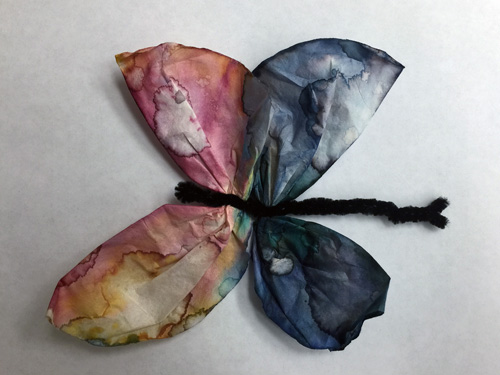Introduction
Some artists use the way paint moves on a surface to produce interesting shapes and designs. Many artists paint on a canvas, a type of fabric that is very absorbant. Before painting on canvas, most artists treat the surface of the canvas so that it does not absorb as much liquid. The artist Helen Frankenthaler did not prepare her canvas in this way. Frankenthaler used the absorbant property of the canvas to create interesting shapes and patterns. To make a painting, she would tack a canvas onto the floor and pour the paint directly onto the surface. She would let the way the paint moved over the canvas to help decide what the picture would be.
In this activity, students paint with water over marker designs on coffee filters. This produces different shapes and beautiful works of art. Chemically, what is happening is that the filter is made up of a special type of paper that absorbs water very easily. Paper towels are made of a similar type of paper. The colors in the markers dissolve, or are soluble in, water. When the water is painted onto the coffee filter, the colors dissolve in the water. As the paper filter absorbs the water, the dissolved colors move with the water and create the resulting color patterns.
Materials
- Two circular white coffee filters
- One pipe cleaner
- Water-based markers of various colors
- Clean scrap paper with nothing on it
- Paintbrush
- Paper towel
- Water (for rinsing)
Procedure
- Place the coffee filters on top of a piece of scrap paper. Use several different colored markers to create a design or pattern on each coffee filter. Note that this design will be changed when the directions in step three are carried out.
- Place both coffee filters on another piece of scrap paper.
- Dip the paintbrush in the water and paint over the designs with the wet brush. Be certain to rinse the brush in the water several times while you are painting with the water. Watch how the designs change.
- Fold the pipe cleaner in half. Hold the pipe cleaner about 2 cm from the fold and twist two times. This will leave a small loop.
- Scrunch one of the coffee filters along an imaginary line down the middle of the filter to produce one set of butterfly wings.
- Place this filter inside the open ends of the pipe cleaner, centering it close to the twisted end.
- Repeat step five with the other coffee filter. This is the second set of the butterfly’s wings. Place it above the first filter, inside the open ends of the pipe cleaner.
- Twist the two pieces of the pipe cleaner together about 4 cm from the open end of the pipe cleaner. This will hold the two filters in place.
- Turn down the ends of the pipe cleaner to look like antennae.
- Thoroughly clean the work area and wash your hands.
Drying Hint: Place the folded end of the pipe cleaner in the end of a straw. Balance the straw in a glass or jar. More than one butterfly can be dried in the same jar this way. The coffee filters can be dried on a paper towel before scrunching them and putting them in the pipe cleaner.
Safety
This experiment is relatively safe. All products can be purchased from a grocery store and there are no major safety issues.
Disposal of Waste Products
No special requirements. Everything can be discarded through normal disposal procedures.

